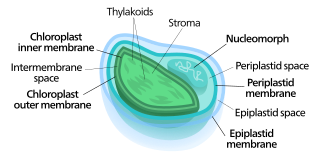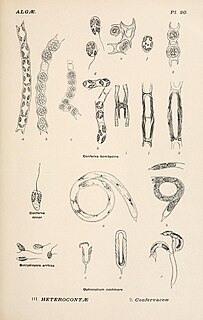Related Research Articles

The cryptomonads are a group of algae, most of which have plastids. They are common in freshwater, and also occur in marine and brackish habitats. Each cell is around 10–50 μm in size and flattened in shape, with an anterior groove or pocket. At the edge of the pocket there are typically two slightly unequal flagella.

Chromista is a biological kingdom consisting of single-celled and multicellular eukaryotic species that share similar features in their photosynthetic organelles (plastids). It includes all protists whose plastids contain chlorophyll c, such as some algae, diatoms, oomycetes, and protozoans. It is probably a polyphyletic group whose members independently arose as separate evolutionary group from the common ancestor of all eukaryotes. As it is assumed the last common ancestor already possessed chloroplasts of red algal origin, the non-photosynthetic forms evolved from ancestors able to perform photosynthesis. Their plastids are surrounded by four membranes, and are believed to have been acquired from some red algae.
Cryptomonas is the name-giving genus of the Cryptomonads established by German biologist Christian Gottfried Ehrenberg in 1831. The algae are common in freshwater habitats and brackish water worldwide and often form blooms in greater depths of lakes. The cells are usually brownish or greenish in color and are characteristic of having a slit-like furrow at the anterior. They are not known to produce any toxins. They are used to feed small zooplankton, which is the food source for small fish in fish farms. Many species of Cryptomonas can only be identified by DNA sequencing. Cryptomonas can be found in several marine ecosystems in Australia and South Korea.

Nucleomorphs are small, vestigial eukaryotic nuclei found between the inner and outer pairs of membranes in certain plastids. They are thought to be vestiges of primitive red and green algal nuclei that were engulfed by a larger eukaryote. Because the nucleomorph lies between two sets of membranes, nucleomorphs support the endosymbiotic theory and are evidence that the plastids containing them are complex plastids. Having two sets of membranes indicate that the plastid, a prokaryote, was engulfed by a eukaryote, an alga, which was then engulfed by another eukaryote, the host cell, making the plastid an example of secondary endosymbiosis.

Yellow-green algae or the Xanthophyceae (xanthophytes) are an important group of heterokont algae. Most live in fresh water, but some are found in marine and soil habitats. They vary from single-celled flagellates to simple colonial and filamentous forms. Xanthophyte chloroplasts contain the photosynthetic pigments chlorophyll a, chlorophyll c, β-carotene, and the carotenoid diadinoxanthin. Unlike other heterokonts, their chloroplasts do not contain fucoxanthin, which accounts for their lighter colour. Their storage polysaccharide is chrysolaminarin. Xanthophyte cell walls are produced of cellulose and hemicellulose. They appear to be the closest relatives of the brown algae.

The cryptophyceae are a class of algae, most of which have plastids. About 220 species are known, and they are common in freshwater, and also occur in marine and brackish habitats. Each cell is around 10–50 μm in size and flattened in shape, with an anterior groove or pocket. At the edge of the pocket there are typically two slightly unequal flagella.
In molecular biology, a twintron is an intron-within-intron excised by sequential splicing reactions. A twintron is presumably formed by the insertion of a mobile intron into an existing intron.
Telonemia is a phylum of microscopic eukaryote, single-celled organisms. They were formerly classified as protists until that kingdom fell out of general use, and are suggested to have evolutionary significance in being a possible transitional form between ecologically important heterotrophic and photosynthetic species among chromalveolates.

The cryptomonads-haptophytes assemblage is a proposed monophyletic grouping of unicellular eukaryotes that are not included in the SAR supergroup. Several alternative names have been used for the group, including Hacrobia ; CCTH ; and "Eukaryomonadae".

Rhodomonas is a genus of cryptomonads.
Geminigera /ˌdʒɛmɪnɪˈdʒɛɹə/ is a genus of cryptophyte from the family Geminigeraceae. Named for its unique pyrenoids, Geminigera is a genus with a single mixotrophic species. It was discovered in 1968 and is known for living in very cold temperatures such as under the Antarctic ice. While originally considered to be part of the genus Cryptomonas, the genus Geminigera was officially described in 1991 by D. R. A. Hill.
Falcomonas is a genus of cryptophytes placed in the family Chroomonadaceae.
Hemiselmis is a genus of cryptomonads.
Mesodinium chamaeleon is a ciliate of the genus Mesodinium. It is known for being able to consume and maintain algae endosymbiotically for days before digesting the algae. It has the ability to eat red and green algae, and afterwards using the chlorophyll granules from the algae to generate energy, turning itself from being a heterotroph into an autotroph. The species was discovered in January 2012 outside the coast of Nivå, Denmark by professor Øjvind Moestrup.
Rastrimonas is a monotypic genus of parasitic alveolates in the phylum Apicomplexa. It contains the single species Rastrimonas subtilis. It was described in 2002 from the free-living cryptomonad Chilomonas paramaecium and placed in the new genus Cryptophagus. The following year this was renamed Rastrimonas.
Goniomonadea is a proposed class of cryptomonads which includes the orders Goniomonadida and Hemiarmida.

Pyrenomonadaceae is a family of cryptomonads which includes three or four known genera. They are distinguished from other cryptomonads by their nucleomorphs being imbedded into the pyrenoid, and the presence of distinctive pigment phycoerythrin 545.
Chroomonadaceae is a family of cryptomonads first recognized by Clay et al in 1999 as including genera Chroomonas, Falcomonas, and Komma. Following a molecular phylogenic study in 2002, Hemiselmis was also placed within the Chroomonadaceae. Today, the family is generally recognized as sister to the Pyrenomonadaceae.
Cryptochrysis is a formerly recognized genus of cryptomonads first proposed by Adolf Pascher in 1911. He initially treated it as the sole genus in family Cryptochrysidaceae, but later treated it as a member of the Cryptochrysideae subfamily of Cryptomonadaceae, along with Rhodomonas, Chroomonas, and Cyanomonas. In 1967, R.W. Butcher relegated the group to a subgenus within Chroomonas.
Bjornbergiella hawaiiensis is a Hawaiian species of cryptomonad described in 1965. It is the sole member of the genus Bjornbergiella.
References
- ↑ Novarino and Lucas (1993), "Some proposals for a new classification system of the Cryptophyceae", Botanical Journal of the Linnean Society, 111 (1): 3–21, doi:10.1006/bojl.1993.1002
- ↑ Bicudo (1965), "Bjornbergiella, a New Genus of Cryptophyceae from Hawaiian Soil", Phycologia, 5 (4): 217–221, doi:10.2216/i0031-8884-5-4-217.1